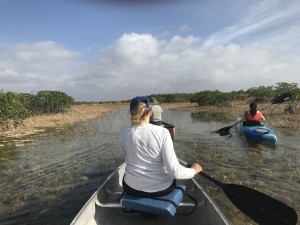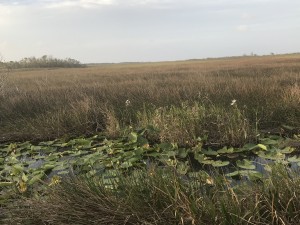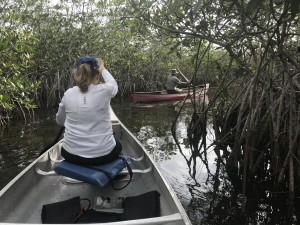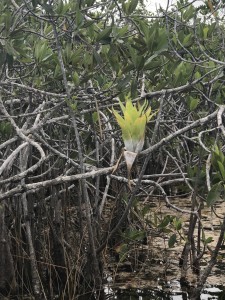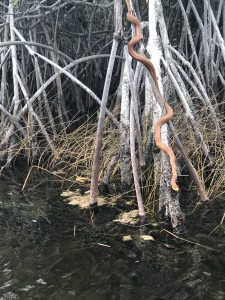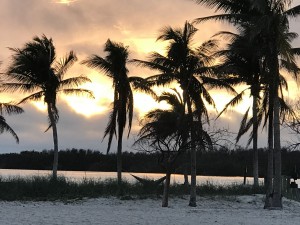“One touch of nature makes the whole world kin.”
― John Muir
On Saturday, January 29, 2018, CELL gave a Climate Action Now (CAN) program for a group of 40 Miami high school students volunteering at Shake a Leg Miami, a non profit organization providing sailing and marine education programs for children and adults with physical, developmental and
economic challenges. During the month of January, we conducted CAN programs for twelve schools – reaching over 400 students. Each program culminated in a challenge to the students to identify an issue at their school or within their community that they can proactively solve through working together. Check out this inspiring video for an example of what a group of high school students did in Santa Monica, California to ban single use plastics: Team Marine. Youth can have a powerful voice – especially when they choose to collectively use it and to tenaciously never give up.
After the Saturday morning presentation, Sue and I took off to explore the Everglades National Park – the largest designated wilderness in the eastern U.S. and the only subtropical preserve on the
North American continent. The Park is a 1.5 million acre wetlands preserve comprised of coastal mangroves, sawgrass marshes, and pine flatwoods that are home to hundreds of animal species. Seventy-three threatened or endangered species call the Everglades home, including the leatherback turtle, Florida panther, and manatee. It is the largest mangrove ecosystem in the western hemisphere and the most significant breeding grounds for tropical wading birds in North America.
Did you know, that:
- One out of every three Floridians (8 million people) rely on the Everglades for their water supply.
- While often described as a swamp or forested wetland, the Everglades is actually a very slow-moving river.
- Birds were once so plentiful in the Everglades that they “darkened the sky” when they took flight.
- The Everglades is the only place in the world where the American Alligator and the American Crocodile co-exist in the wild.
- The Everglades has only two seasons each year: dry season (winter) and wet season (summer).
- The Everglades is primarily fresh-water and receives, on average, 75 inches of rain per year.
- The Everglades National Park is the third largest National Park in the lower 48 states after __________ and __________ (which parks are one and two? Answer at end of Blog).
The Everglades ecosystem is often referred to as the “most threatened park in the U.S.” Development pressure from agriculture, industry, and urban areas has destroyed more than half of the original Everglades. Upstream water diversion for human use has interrupted the flow of water into the National Park and disrupts feeding and nesting cycles. And introduced species pose a threat to the native habitats and delicate ecosystem of the Everglades.
Our National Parks have been referred to as “America’s greatest idea!” Millions visit our national parks annually and their awe-inspiring natural beauty has literally changed the course of people’s lives. Girls and boys participating in young naturalists programs, for example, have grown up to become naturalists. Visiting national and state parks, wildlife refuges, and monuments, we feel connected to something larger than ourselves and take something away that feeds our soul and nourishes our heart. Our parks are a national treasure, and they need our protection.
Your national parks, however, are currently under siege from a lack of funding to maintain
infrastructure and programming and from an administration that wants to reduce their size and open them to resource extraction. The national parks are our parks; they belong to you and me and to your children and their children’s children – not to corporations and industries that want to pilfer them for private gain. They are worth fighting to protect. Check out this link of 10 Ways to Be a Park Advocate for ideas on what you can do to help OUR national parks.
Sue’s and my favorite memory of our visit to the Everglades was an early morning 3 ½ hour canoe
paddle with a park naturalist across shallow two-foot deep marshes and through a labyrinth of dense red mangrove trees with their ubiquitous leg-like roots, stepping out in all directions. We saw Great egrets and Wood storks, American crocodiles and Turkey vultures, sawgrass and bromeliads (air-born, pineapple-looking plants that attach themselves to mangroves and other trees), a Florida soft-shell turtle and a motionless red rat snake wrapped around the leg of a mangrove as we softly paddled by. We felt intimately connected with nature around us.
It’s been said: “We are nature; and nature is us.” If we want to preserve
the wonder of our national parks for our children and their children’s children to enjoy and be nurtured by, we need to find ways for kids today to have a relationship with these awe-inspiring areas. It is not enough to simply know they exist. We need to get kids out to see, touch, feel, and experience their life-changing awe and beauty. Perhaps all of us have seen dazzling pictures of our national parks in calendars, posters and in books on coffee tables and been inspired by them. But to stand on the rim of the Grand Canyon or paddle softly through the Everglades or sit on a granite shelf atop Mt. Cadillac at Acadia National Park while the sun sets or rises – is a moment you will never forget. It is difficult to put into words what happens to one standing silently or sitting quietly soaking in the magic of our national parks, but suffice it to say that it can change you forever. In these moments of deep spiritual connection to wild places, something larger than ourselves reaches out, grabs us and embraces our soul’s desire and invites us to live a life of equal grandeur. We protect what we love; it’s that simple. And when kids today fall in love with our national parks, they will work to protect them tomorrow when they are adults.
What shaped the lives of people like Rachel Carson, John Muir, and other famous scientists and
naturalists? They spent time outdoors as a child with a caring adult. You could be that caring adult sharing a love for the outdoors with children today. Who knows, it might ignite a life-long love for our natural world and create a cavalry of stewards for our national parks and sacred wild places. As John Muir said: “One touch of nature makes the whole world kin.”
Never underestimate the role that you can play today in making our planet a healthier, happier place to live. The world has great need of your passion and action!
Stay tuned: Our next blog will focus on “How to build bi-partisan support for action on climate change.”
Answer to question above: The Everglades National Park is the third largest National Park in the lower 48 states after Yellowstone and Death Valley.
To subscribe to (or unsubscribe from) these blog posts, write to jonathan@cellonline.org.
*CELL is currently accepting applications for college sustainability focused study abroad programs, to Iceland, Central America, Ecuador, and Scotland. Faculty may contact CELL regarding custom programs for your college. Go to cellonline.org for more information and to apply.”

